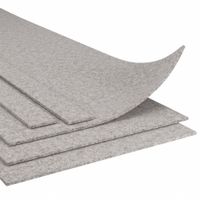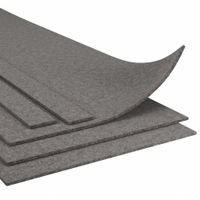Call +(254) 703 030 000 / 751 483 999 / 721 704 777
- Home
- Raw Materials
- Felt
- Felt Sheets Strips Rolls
.....Read More
Frequently Asked Questions
What are the different grades of felt based on wool content?
Felt is categorized into different grades based on the wool content, which affects its quality, texture, and application. The primary grades of felt based on wool content are:
1. **100% Wool Felt**: This is the highest quality felt, made entirely from wool fibers. It is known for its durability, softness, and excellent insulating properties. It is often used in high-end applications such as fashion, musical instruments, and industrial uses where superior quality is required.
2. **Wool Blend Felt**: This grade contains a mixture of wool and other fibers, typically synthetic ones like polyester or rayon. The wool content can vary, commonly ranging from 20% to 90%. The higher the wool content, the better the quality. Wool blend felt is versatile and used in crafts, decorations, and some industrial applications.
3. **Synthetic Felt**: Made entirely from synthetic fibers such as polyester, acrylic, or rayon, this felt is less expensive and more readily available. It lacks the natural qualities of wool, such as breathability and moisture-wicking, but is suitable for crafts, decorations, and some industrial uses where cost is a significant factor.
4. **Needle-Punched Felt**: This type of felt can be made from wool, synthetic fibers, or a blend. The fibers are mechanically interlocked using barbed needles, creating a dense and durable fabric. The wool content can vary, and it is often used in automotive, filtration, and soundproofing applications.
5. **Pressed Felt**: Also known as traditional felt, it is made by compressing wool fibers with heat, moisture, and pressure. The wool content can vary, and it is used in applications requiring a dense and firm material, such as in gaskets, seals, and padding.
Each grade of felt has distinct characteristics and is chosen based on the specific requirements of the application.
How do I choose the right durometer and density for felt sheets and strips?
To choose the right durometer and density for felt sheets and strips, consider the following factors:
1. **Application Purpose**: Determine the specific use of the felt. For cushioning, softer felts with lower durometer and density are ideal. For structural support or heavy-duty applications, opt for higher durometer and density.
2. **Material Type**: Decide between wool, synthetic, or blended felts. Wool felt generally offers better resilience and durability, while synthetic options might provide cost benefits and specific properties like water resistance.
3. **Load and Pressure**: Assess the load the felt will bear. Higher durometer and density are suitable for high-pressure applications to prevent deformation and ensure longevity.
4. **Environmental Conditions**: Consider exposure to elements like moisture, heat, or chemicals. Higher density felts often provide better resistance to environmental factors.
5. **Thickness Requirements**: Thicker felts can distribute loads more evenly, which might allow for a lower density or durometer. However, if space is limited, a denser material might be necessary to achieve the same performance.
6. **Vibration and Noise Reduction**: For applications requiring vibration dampening or noise reduction, medium to high-density felts with moderate durometer are effective.
7. **Cost Considerations**: Higher density and durometer felts are typically more expensive. Balance performance needs with budget constraints.
8. **Testing and Prototyping**: If possible, test samples in real-world conditions to ensure the chosen felt meets all performance criteria.
By evaluating these factors, you can select the appropriate durometer and density for your specific needs, ensuring optimal performance and durability of the felt sheets and strips in their intended application.
What are the common applications for soft felt?
Soft felt is a versatile material with a wide range of applications across various industries. Common applications include:
1. **Crafting and DIY Projects**: Soft felt is popular in crafting due to its ease of cutting and shaping. It is used to make decorations, ornaments, and toys. Its vibrant colors and textures make it ideal for creating visually appealing projects.
2. **Fashion and Accessories**: In the fashion industry, soft felt is used to make hats, bags, and other accessories. Its soft texture and ability to hold shape make it a preferred material for stylish and functional items.
3. **Home Décor**: Soft felt is used in home décor for items like coasters, placemats, and wall hangings. Its insulating properties make it suitable for protecting surfaces and adding aesthetic value to interiors.
4. **Soundproofing and Insulation**: Due to its density and texture, soft felt is used in soundproofing applications. It is employed in recording studios, theaters, and homes to reduce noise levels and improve acoustics.
5. **Automotive Industry**: In vehicles, soft felt is used for lining interiors, providing sound insulation, and protecting surfaces. It is also used in trunk liners and door panels for its durability and noise-reducing properties.
6. **Industrial Applications**: Soft felt is used in machinery for gaskets, seals, and padding. Its ability to absorb vibrations and reduce friction makes it valuable in industrial settings.
7. **Educational Tools**: In educational settings, soft felt is used for creating interactive boards and teaching aids. Its tactile nature makes it engaging for children and effective for learning activities.
8. **Medical Uses**: Soft felt is used in medical applications for padding and cushioning in orthotics and prosthetics, providing comfort and support to patients.
These diverse applications highlight the adaptability and utility of soft felt across different sectors.
How is firm felt used in industrial settings?
Firm felt is utilized in industrial settings for its durability, resilience, and versatility. It is commonly used for cushioning, sealing, and insulation purposes. In machinery, firm felt serves as a gasket material, providing a reliable seal between components to prevent leaks and reduce vibration. Its ability to withstand high temperatures and pressures makes it ideal for such applications.
In the automotive industry, firm felt is used for soundproofing and vibration damping. It is often applied in door panels, dashboards, and undercarriages to minimize noise and enhance the comfort of vehicles. Additionally, its insulating properties help in maintaining temperature control within the vehicle.
Firm felt is also employed in the manufacturing of polishing wheels and pads. Its dense structure allows for effective polishing and buffing of metals, glass, and other materials, providing a smooth finish without causing damage to the surfaces.
In the textile industry, firm felt is used in the production of hats, shoes, and other apparel items, offering structure and support. Its ability to be easily cut and shaped makes it a preferred material for designers and manufacturers.
Furthermore, firm felt is used in filtration systems, particularly in air and liquid filters. Its fibrous composition traps particles effectively, ensuring clean air and fluids in various industrial processes.
Overall, firm felt's adaptability to different environments and its functional properties make it a valuable material in numerous industrial applications, contributing to efficiency, safety, and product quality.
What are the benefits of using hard felt for buffing and vibration dampening?
Hard felt offers several benefits for buffing and vibration dampening:
1. **Durability**: Hard felt is robust and long-lasting, making it ideal for repeated use in buffing applications. Its dense structure withstands wear and tear, ensuring consistent performance over time.
2. **Surface Finish**: In buffing, hard felt provides a smooth, even finish. Its firm texture allows for precise control, effectively polishing surfaces to a high shine without causing scratches or damage.
3. **Versatility**: Hard felt can be used with various compounds and on different materials, including metals, plastics, and glass. This versatility makes it suitable for a wide range of industrial and craft applications.
4. **Absorption**: The material's ability to absorb and retain polishing compounds enhances its effectiveness in buffing, ensuring even distribution and reducing waste.
5. **Vibration Dampening**: Hard felt's dense, fibrous structure effectively absorbs and dissipates vibrations. This property is crucial in machinery and equipment, where reducing vibration can prevent wear, minimize noise, and improve operational stability.
6. **Customization**: Hard felt can be easily cut and shaped to fit specific tools or machinery, allowing for tailored solutions in both buffing and vibration dampening applications.
7. **Cost-Effectiveness**: Given its durability and efficiency, hard felt is a cost-effective choice. It reduces the need for frequent replacements and maintenance, offering long-term savings.
8. **Eco-Friendly**: Made from natural fibers, hard felt is biodegradable and environmentally friendly, aligning with sustainable practices.
Overall, hard felt's combination of durability, effectiveness, and versatility makes it an excellent choice for both buffing and vibration dampening needs.
How does felt absorb oil and grease?
Felt absorbs oil and grease primarily due to its unique structure and material properties. Felt is a non-woven textile made by matting, condensing, and pressing fibers together. This structure creates a dense network of fibers with numerous tiny pores and capillaries, which enhances its absorbent capabilities.
The fibers in felt are typically made from natural materials like wool or synthetic fibers such as polyester. Wool fibers, in particular, have a scaly surface and a natural crimp, which increases the surface area and creates more spaces for trapping liquids. The hydrophobic nature of wool also makes it more effective at absorbing non-polar substances like oil and grease, as it repels water while attracting and holding onto oils.
The capillary action within the felt's fibrous network allows it to draw in and retain oil and grease. When oil or grease comes into contact with felt, it is pulled into the material through these capillaries, where it is held by the fibers. This process is facilitated by the surface tension of the oil, which helps it spread and be absorbed more efficiently.
Additionally, the density and thickness of the felt can be adjusted to enhance its absorbency. Thicker and denser felts have more fibers and capillaries, increasing their capacity to absorb and retain larger quantities of oil and grease.
Overall, the combination of felt's fibrous structure, material properties, and capillary action makes it an effective material for absorbing oil and grease, making it useful in various applications such as cleaning, filtration, and spill containment.
What factors should be considered when selecting felt for abrasion resistance?
When selecting felt for abrasion resistance, consider the following factors:
1. **Material Composition**: Choose felts made from durable fibers like wool or synthetic blends, as they offer better abrasion resistance compared to cotton or other natural fibers.
2. **Density and Thickness**: Higher density and thicker felts generally provide better abrasion resistance. The compactness of the fibers helps withstand wear and tear.
3. **Fiber Quality**: Long-staple fibers tend to interlock more effectively, enhancing the felt's durability and resistance to abrasion.
4. **Needle Punching**: Felts that are needle-punched have fibers that are mechanically interlocked, increasing their strength and resistance to abrasion.
5. **Chemical Treatments**: Some felts are treated with chemical finishes to enhance their abrasion resistance. Consider felts with such treatments if additional durability is required.
6. **Surface Finish**: A smoother surface finish can reduce friction and wear, contributing to better abrasion resistance.
7. **Environmental Conditions**: Consider the conditions the felt will be exposed to, such as moisture, temperature, and UV exposure, as these can affect its abrasion resistance.
8. **Load and Pressure**: Evaluate the expected load and pressure the felt will endure. Higher loads may require more robust felts with superior abrasion resistance.
9. **Application**: The specific application (e.g., industrial, automotive, or apparel) will dictate the level of abrasion resistance needed. Match the felt's properties to the demands of the application.
10. **Testing Standards**: Look for felts that have been tested and rated for abrasion resistance according to industry standards, ensuring reliability and performance.
11. **Cost and Availability**: Balance the cost with the required performance. High-performance felts may be more expensive but offer longer service life.
12. **Manufacturer Reputation**: Choose felts from reputable manufacturers known for quality and consistency in their products.



